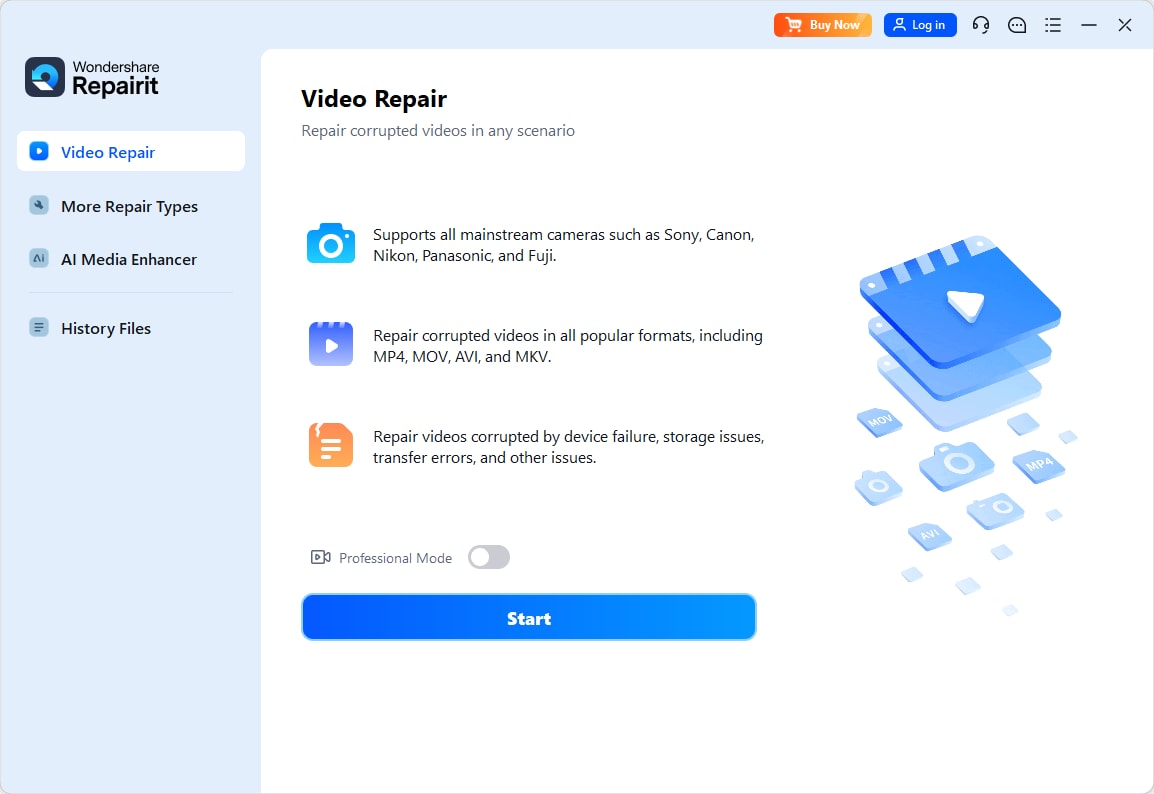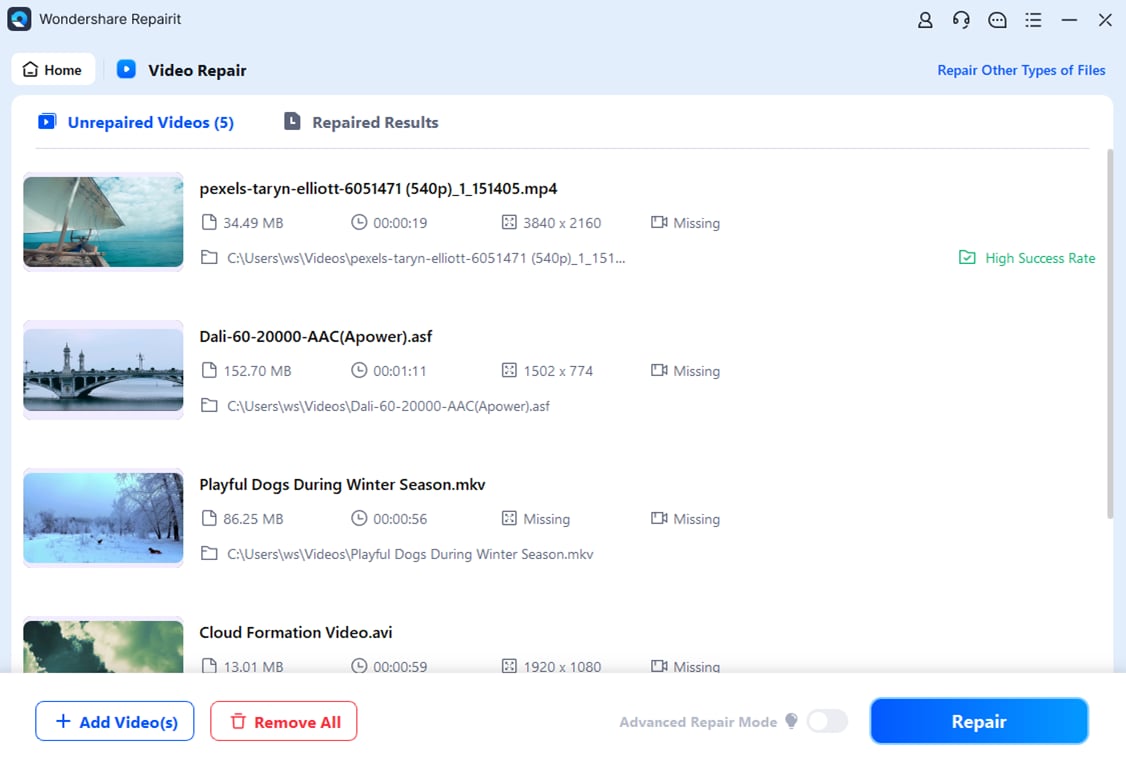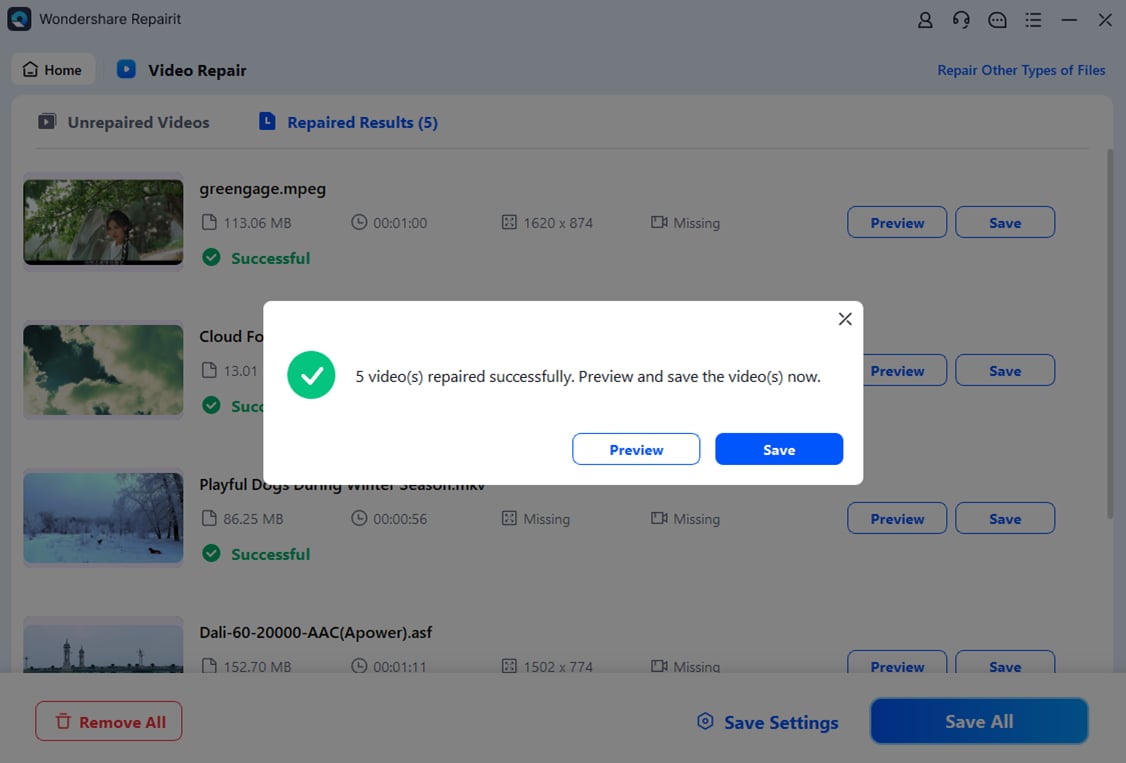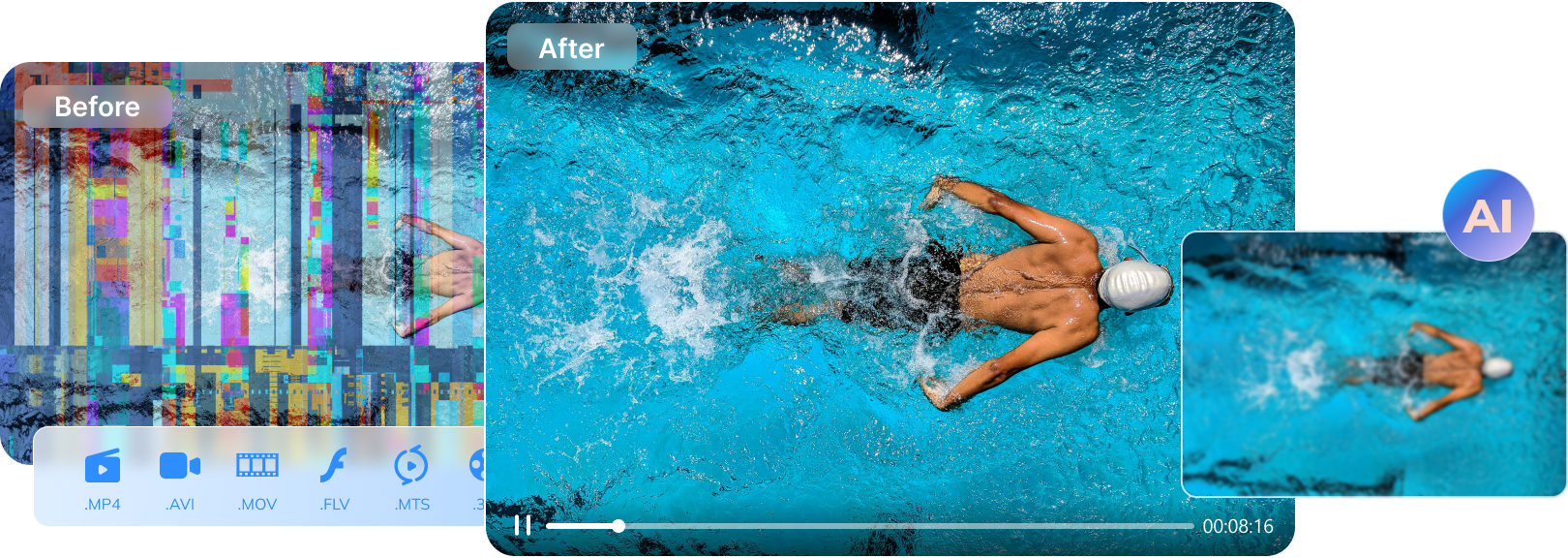Experiencing a black screen in Windows can be frustrating and affect the overall workflow. This usually happens when your software malfunctions due to incorrect display settings or hardware problems. Regardless of the reason, learning how to repair a black screen is crucial to fixing this issue and getting back to work quickly.
However, beginners out there seek a seamless and straightforward solution that doesn’t require additional setup. If you are among them too, we have gathered comprehensive solutions in this guide for your assistance. So, review our 5 fixes and learn how to repair the black screen of Windows 10 in real time.
In this article
Part 1. Why Is Your Windows 10/11 Screen Black?
Before you head to fixing the black screen, do you know what factors could be causing this vexing issue? If not, this section contains 5 simple reasons to determine the root cause of the black screen on Windows.
| Cause of Black Screen | Description |
| Graphics Driver Issues | Sometimes, when the graphic driver is outdated or corrupted, it can prevent the screen from being displayed properly. Therefore, to resolve this issue, users can either update their device or reinstall the driver. |
| Loose or Faulty Connections | Besides that, if the cable connection to the computer is loose or damaged, it can also cause a black screen issue. Hence, ensure that the wire you use is in good condition to establish a secure connection. |
| Power Problems | Other than cable issues, when the device doesn’t receive enough power, it can also cause this problematic situation. Thus, to overcome this, it is better to check the power supply and ensure that everything is plugged in. |
| Software Conflicts | Furthermore, certain software updates and settings can lead to blackscreen issues in Windows. In this case, boot the system in safety mode and uninstall recent updates to restore the device to normal condition. |
| Faulty Hardware | Finally, damaged hardware, such as a motherboard or GPU, can also affect the functionality of monitors. Therefore, ensure that the hardware you are using is damage-free, or try using the existing ones with another device to know if it's causing the issue. |
Part 2. How to Fix a Black Screen in Windows 10/11?
Knowing this brief's fixes isn't enough; therefore, we have mentioned detailed ways to resolve the black screen video here. After reviewing each solution in detail, you can quickly fix the black screen issue on Windows 10/11 and continue working.
Fix 1. Check Your External Monitor
As mentioned, damaged or inadequately plugged cables can also cause black screen issues in Windows. Hence, to resolve this, ensure the cable you are using is securely attached to the monitor. If the problem persists, use another cable or port to rule out a faulty connection. In addition, you can test the monitor with another device to see where the problem actually is.

Fix 2. Check Cables and Connections
For Windows repair black screen, users can also check if the connected cables have any external or internal damage. In case of any damage, replace them immediately with a new one to fix this issue. However, if you are still having this problem, test the cable with another monitor and determine if it needs to be changed.
Fix 3. Try a BIOS/UEFI Reset and Check the Boot Order
In many cases, a black screen can occur due to changes in the BIOS settings or the boot order. When multiple storage drives are installed on your PC, BIOS can face problems detecting the correct booting device.
To check whether this is the root cause and to repair the black screen, check the boot order manually. You can easily check and rearrange the boot order by following the steps given below:
Step 1. First, turn on your computer and immediately press the F2 key, which may vary according to system manufacturers, to enter the boot menu. Make sure to confirm the key boot by searching your computer’s model name online. Once the boot menu appears, use the “Arrow” keys on your keyboard to go to the “Enter Setup” option and click “Enter.”

Step 2. After reaching the BIOS Utility screen, use the “Arrow” keys to navigate to the “Boot” section. Here, you will find all the boot devices listed according to their order. Use the “+” and “-” keys on your keyboard to reorder the boot devices.

Step 3. Finally, when the correct boot order is selected, press the “F10” key to save it. From the small pop-up that appears to confirm your selection, press “Enter” on your keyboard.

Fix 4. Refresh the Screen via Windows Key Sequence
Out of all the ways to repair a black screen, the easiest one is to use Windows shortcut keys. This method is useful when the issue is related to minor glitches and not with hardware or software. Since you can find many shortcut keys, the one sequence that works all the time and resets graphic drivers. You can follow the given key sequence on your Windows PC to reawake your screen:
“Windows Logo Key + CTRL + SHIFT + B”

Fix 5. Restore Window to the Previous Version
If these methods don’t work, the final solution is to restore your Windows to the previous versions. Before continuing with this method, ensure you have a secure backup somewhere since it uninstalls your recent programs.
Additionally, there are many ways to proceed with this process. However, as evident in the following steps, we’re going to take a secure route.
Step 1. To commence the process, you need to restart your PC thrice by pressing the power button. On your third try, the PC will boot in the Recovery Environment. Once there, you need to access the “Troubleshoot” option.

Step 2. The troubleshooting menu will display two choices from which you need to choose “Advanced Options.”

Step 3. You will find six more options when the computer takes you to the new screen. Here, we are going to use “Command Prompt” as it will help you access any option.

Step 4. Once the Command Prompt appears on the screen, you need to enter the “rstrui.exe” and press “Enter.”

Step 5. This will take you to the "System Restore" wizard, where you can easily go back to a previous version of Windows. To start with the wizard, press the "Next" button and go with the on-screen instructions to repair the black screen.

Part 3. The Perfect Video Repair Tool to Fix Black Screen Video to Bring Back Its Original Quality
Other than resolving black screen issues, if you face issues with your videos, consider using Repairit to fix corrupted or inaccessible content. Using this tool, you can easily repair corrupted black screen video since it supports various video formats like MP4, MOV, AVI, or MTS. In addition, it features a batch processing facility through which you can add more than one video to repair and save manual effort.
Besides Windows, if you have damaged videos on devices like Canon, GoPro, or Panasonic, it can fix it without affecting the original data. Furthermore, it can enhance the video resolution from 19201080 or 1280720 for sharp and detailed visuals. After resolving the issue, you can preview the fixed video file to see if its quality and playback have been restored.
Key Features of Repairit Video Repair
- Repair Corrupt Video Files Using FFmpeg: Using the FFmpeg command line, this tool can convert, transcode, encode, and decode video files to repair the corrupted ones.
- Two Repair Modes: For fixing the black screen or playback issues, it offers two different modes, such as quick and advanced repair.
- Online video repairing solution: Being a versatile tool, it can be easily accessed on various platforms online without having compatibility issues.

-
Repair damaged videos with all levels of corruption, such as video not playing, video no sound, out-of-sync video or audio, playback errors, header corruption, flickering video, missing video codec, etc.
-
Repair full HD, 4K, and 8K videos and support 18 popular formats, including MOV, MP4, M2TS, INSV, M4V, WMV, MPEG, ASF, etc.
-
Repair damaged or corrupted videos caused by video compression, system crashes, video format changes, etc.
-
Repair critically damaged or corrupted videos available on SD cards, mobile phones, cameras, USB flash drives, etc.
-
Repairit has a quick and advanced scanning mode. You can use either depending on the level of corruption the video file has undergone.
-
No limit to the number and size of the repairable videos.
-
Support Windows 11/10/8/7/Vista, Windows Server 2003/2008/2012/2016/2019/2022, and macOS 10.12~macOS 13.
Step-by-Step Guide to Fix Black Screen Video with Repairit
Upon learning how this tool fixes damaged or corrupted video, here is how you can repair a black screen on Windows 10.
Step 1. Launch the Repairit Video Repair Tool on Your PC
Download and access the Wondershare Repairit on your PC and press the “+Add” button from the “Video Repair” feature.

Step 2. Choose the Damaged File and Start the Process
Confirm that all the damaged videos are uploaded and hit the “Repair” button to let the tool resolve the black screen issue.

Step 3. Preview the Fixed Video File and Save on Your Device
After the process is completed, a pop-up will be displayed, and you will have to press the “Save” option to save them on your device. Before that, you can use the "Preview" button to review changes.

Repair Black Screen Video Files Now

Conclusion
Summing up, learning seamless methods of fixing black screens is crucial as this issue can happen anytime and affect the user’s productivity. Therefore, in this guide, we have covered possible reasons and solutions to resolve this issue.
Moreover, it is better to consider Repairit as it can support and fix black screen video of any format. Plus, with its batch processing facility, you can import multiple files and save effort.
FAQ
-
Q1. Why does my Windows 10/11 screen turn black after logging in?
Usually, a black screen issue occurs because of display drivers, incompatible software, or incorrect system updates. In addition, damaged cable connections or hardware can affect the monitor display and affect the overall workflow. -
Q2. How do I check if my hardware is causing the black screen issue?
To verify if hardware is a problem, test your monitor and cables with a different device. Additionally, inspect components like the GPU and motherboard for visible damage or overheating. -
Q3. Will I lose my data while fixing a corrupted or damaged video?
If you use a reliable tool like Repairit, your data integrity will remain intact. Moreover, you can access this tool online on any device to overcome this frustrating issue.


 ChatGPT
ChatGPT
 Perplexity
Perplexity
 Google AI Mode
Google AI Mode
 Grok
Grok

